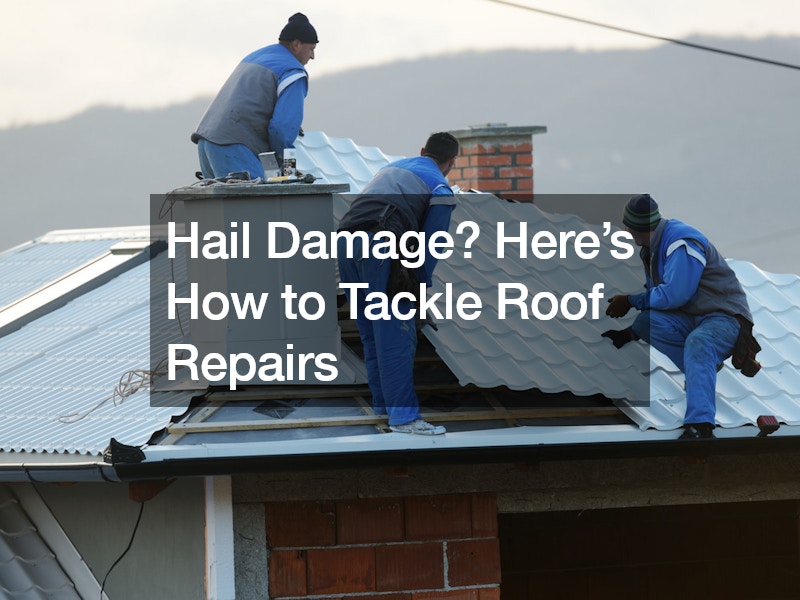Hailstorms can be a homeowner’s worst nightmare, leaving behind a trail of damage that can affect not just the roof but the entire structure of your home. Understanding how to address hail damage promptly and effectively is crucial for maintaining the integrity and safety of your home. Here’s a comprehensive guide on how to tackle roof repairs after a hailstorm.
Assess the Damage
The first step in dealing with hail damage is to assess the extent of the damage. Hailstones can vary in size, and the impact can cause different types of damage to your roof, from minor dents to severe punctures.
Check for dents on shingles, cracks in the siding, and any other signs of impact. It’s also essential to look for granules from shingles in your gutters, as this indicates that your shingles may be compromised.
Verify Your Insurance Coverage
Before making any repairs, it’s crucial to understand what your homeowner’s insurance policy covers. Most homeowner’s policies include hail damage under commonly covered perils, such as wind and fire. However, it’s essential to review your policy details, as some carriers may have specific exclusions or stipulations, especially in areas prone to heavy hail. For instance, certain materials like metal roofs might not be covered for hail damage, so having a detailed discussion with your insurance agent is vital. Specify the type of coverage you need, and ensure that your policy reflects the risks in your area.
Choose a Reputable Roofing Contractor
Working with the best roofer is vital to ensure your roof is repaired correctly and efficiently. Here are some essential tips to help you choose a reliable roofing contractor:
Local Expertise
Always opt for a local contractor. This reduces the risk of dealing with storm chasers who may not return to complete the job. Local contractors are familiar with the local building codes and climate conditions, making them better suited to handle hail damage repairs.
Proper Insurance
Ensure the contractor is fully insured, including general liability and workman’s comp. This protects you from potential liabilities in case of accidents during the repair process.
Check Their Credentials
A reputable contractor should have a professional website with customer reviews and a portfolio of previous work. Check their certifications and whether they have a relationship with roofing material manufacturers. This relationship is crucial as it ensures they can back up warranties and use high-quality materials.
Experience with Insurance Claims
Choose a contractor who is experienced with the insurance claim process. They should be able to guide you through filing the claim, negotiating with the insurance adjuster, and ensuring you get the coverage you are entitled to.
Consider the Right Materials
When it comes to replacing or repairing your roof, the materials you choose can significantly impact its durability and longevity. In areas with frequent hailstorms, investing in impact-resistant shingles is wise. Shingles like IKO Dynasty or Nordic are designed to withstand hail impacts better than standard shingles. These shingles are classified as Class 3 impact-resistant, offering superior protection against hail damage. Although they might come at a higher initial cost, their durability and the potential savings on future repairs make them a worthwhile investment.
Determine When to Repair or Replace
One of the most critical decisions after a hailstorm is whether to repair the damage or replace the entire roof. Here’s a guideline to help you decide:
- Isolated Damage: If the hail damage is limited to a few shingles or a small area, a patch job may be sufficient. This is usually a quicker and less expensive solution.
- Widespread Damage: If multiple areas of the roof are damaged, especially if the hailstorm has caused significant impacts across different slopes, a full roof replacement is often the best option. Patch jobs in such scenarios are akin to putting a Band-Aid on a gaping wound and are unlikely to provide lasting protection.
Partner with Your Contractor
Once you’ve chosen a contractor, maintain open communication throughout the repair process. A good contractor will not only perform the repairs but also guide you on the best practices to protect your home. They should help you understand the warranty details, the materials used, and any necessary follow-up inspections to ensure the repairs are up to standard.
Final Thoughts
Dealing with hail damage can be overwhelming, but with the right approach, you can restore your home to its pre-storm condition effectively. Start by assessing the damage, verifying your insurance coverage, and choosing a qualified roofing contractor. Invest in durable, impact-resistant materials and decide wisely between repairs and a full roof replacement. With these steps, you can keep your home safe, secure, and resilient against future hailstorms.
.


